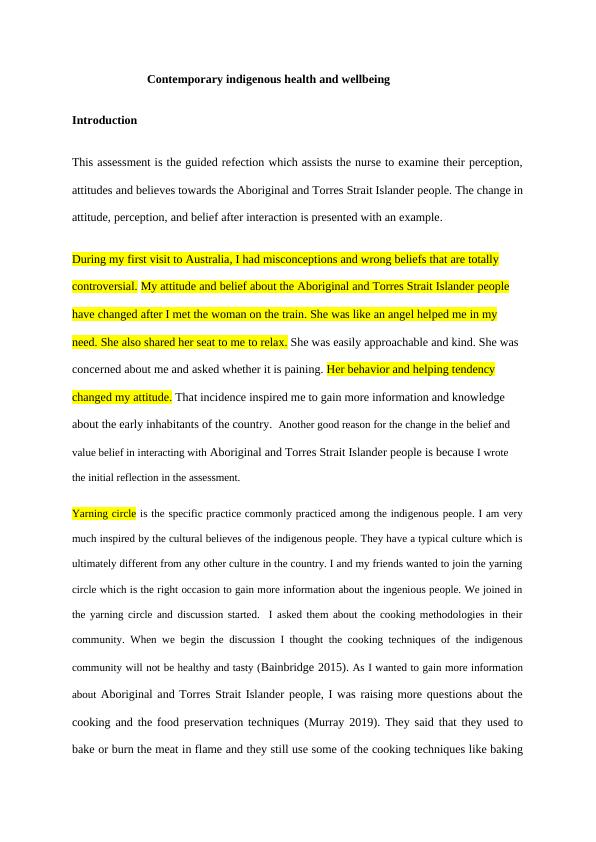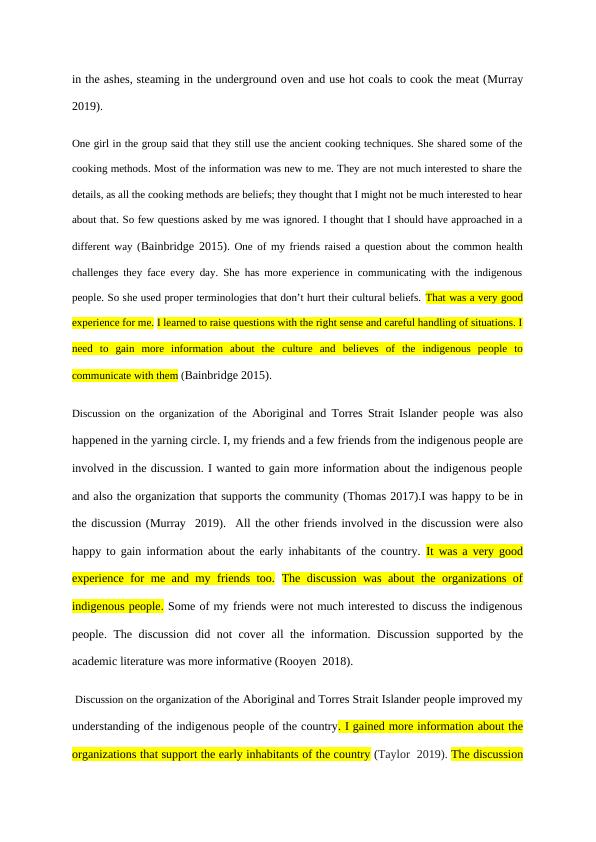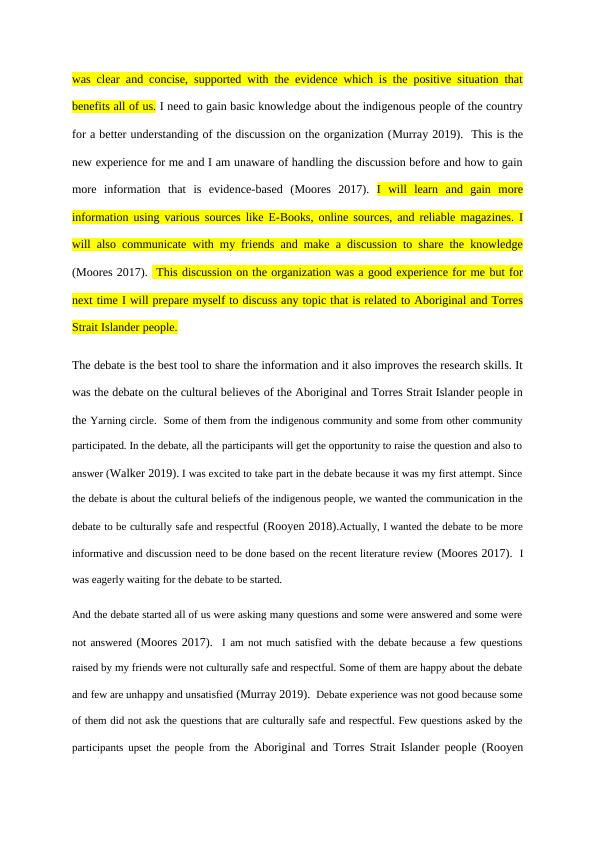Contemporary Indigenous Health and Wellbeing
Added on 2022-10-19
7 Pages2189 Words85 Views
Contemporary indigenous health and wellbeing
Introduction
This assessment is the guided refection which assists the nurse to examine their perception,
attitudes and believes towards the Aboriginal and Torres Strait Islander people. The change in
attitude, perception, and belief after interaction is presented with an example.
During my first visit to Australia, I had misconceptions and wrong beliefs that are totally
controversial. My attitude and belief about the Aboriginal and Torres Strait Islander people
have changed after I met the woman on the train. She was like an angel helped me in my
need. She also shared her seat to me to relax. She was easily approachable and kind. She was
concerned about me and asked whether it is paining. Her behavior and helping tendency
changed my attitude. That incidence inspired me to gain more information and knowledge
about the early inhabitants of the country. Another good reason for the change in the belief and
value belief in interacting with Aboriginal and Torres Strait Islander people is because I wrote
the initial reflection in the assessment.
Yarning circle is the specific practice commonly practiced among the indigenous people. I am very
much inspired by the cultural believes of the indigenous people. They have a typical culture which is
ultimately different from any other culture in the country. I and my friends wanted to join the yarning
circle which is the right occasion to gain more information about the ingenious people. We joined in
the yarning circle and discussion started. I asked them about the cooking methodologies in their
community. When we begin the discussion I thought the cooking techniques of the indigenous
community will not be healthy and tasty (Bainbridge 2015). As I wanted to gain more information
about Aboriginal and Torres Strait Islander people, I was raising more questions about the
cooking and the food preservation techniques (Murray 2019). They said that they used to
bake or burn the meat in flame and they still use some of the cooking techniques like baking
Introduction
This assessment is the guided refection which assists the nurse to examine their perception,
attitudes and believes towards the Aboriginal and Torres Strait Islander people. The change in
attitude, perception, and belief after interaction is presented with an example.
During my first visit to Australia, I had misconceptions and wrong beliefs that are totally
controversial. My attitude and belief about the Aboriginal and Torres Strait Islander people
have changed after I met the woman on the train. She was like an angel helped me in my
need. She also shared her seat to me to relax. She was easily approachable and kind. She was
concerned about me and asked whether it is paining. Her behavior and helping tendency
changed my attitude. That incidence inspired me to gain more information and knowledge
about the early inhabitants of the country. Another good reason for the change in the belief and
value belief in interacting with Aboriginal and Torres Strait Islander people is because I wrote
the initial reflection in the assessment.
Yarning circle is the specific practice commonly practiced among the indigenous people. I am very
much inspired by the cultural believes of the indigenous people. They have a typical culture which is
ultimately different from any other culture in the country. I and my friends wanted to join the yarning
circle which is the right occasion to gain more information about the ingenious people. We joined in
the yarning circle and discussion started. I asked them about the cooking methodologies in their
community. When we begin the discussion I thought the cooking techniques of the indigenous
community will not be healthy and tasty (Bainbridge 2015). As I wanted to gain more information
about Aboriginal and Torres Strait Islander people, I was raising more questions about the
cooking and the food preservation techniques (Murray 2019). They said that they used to
bake or burn the meat in flame and they still use some of the cooking techniques like baking

in the ashes, steaming in the underground oven and use hot coals to cook the meat (Murray
2019).
One girl in the group said that they still use the ancient cooking techniques. She shared some of the
cooking methods. Most of the information was new to me. They are not much interested to share the
details, as all the cooking methods are beliefs; they thought that I might not be much interested to hear
about that. So few questions asked by me was ignored. I thought that I should have approached in a
different way (Bainbridge 2015). One of my friends raised a question about the common health
challenges they face every day. She has more experience in communicating with the indigenous
people. So she used proper terminologies that don’t hurt their cultural beliefs. That was a very good
experience for me. I learned to raise questions with the right sense and careful handling of situations. I
need to gain more information about the culture and believes of the indigenous people to
communicate with them (Bainbridge 2015).
Discussion on the organization of the Aboriginal and Torres Strait Islander people was also
happened in the yarning circle. I, my friends and a few friends from the indigenous people are
involved in the discussion. I wanted to gain more information about the indigenous people
and also the organization that supports the community (Thomas 2017).I was happy to be in
the discussion (Murray 2019). All the other friends involved in the discussion were also
happy to gain information about the early inhabitants of the country. It was a very good
experience for me and my friends too. The discussion was about the organizations of
indigenous people. Some of my friends were not much interested to discuss the indigenous
people. The discussion did not cover all the information. Discussion supported by the
academic literature was more informative (Rooyen 2018).
Discussion on the organization of the Aboriginal and Torres Strait Islander people improved my
understanding of the indigenous people of the country. I gained more information about the
organizations that support the early inhabitants of the country (Taylor 2019). The discussion
2019).
One girl in the group said that they still use the ancient cooking techniques. She shared some of the
cooking methods. Most of the information was new to me. They are not much interested to share the
details, as all the cooking methods are beliefs; they thought that I might not be much interested to hear
about that. So few questions asked by me was ignored. I thought that I should have approached in a
different way (Bainbridge 2015). One of my friends raised a question about the common health
challenges they face every day. She has more experience in communicating with the indigenous
people. So she used proper terminologies that don’t hurt their cultural beliefs. That was a very good
experience for me. I learned to raise questions with the right sense and careful handling of situations. I
need to gain more information about the culture and believes of the indigenous people to
communicate with them (Bainbridge 2015).
Discussion on the organization of the Aboriginal and Torres Strait Islander people was also
happened in the yarning circle. I, my friends and a few friends from the indigenous people are
involved in the discussion. I wanted to gain more information about the indigenous people
and also the organization that supports the community (Thomas 2017).I was happy to be in
the discussion (Murray 2019). All the other friends involved in the discussion were also
happy to gain information about the early inhabitants of the country. It was a very good
experience for me and my friends too. The discussion was about the organizations of
indigenous people. Some of my friends were not much interested to discuss the indigenous
people. The discussion did not cover all the information. Discussion supported by the
academic literature was more informative (Rooyen 2018).
Discussion on the organization of the Aboriginal and Torres Strait Islander people improved my
understanding of the indigenous people of the country. I gained more information about the
organizations that support the early inhabitants of the country (Taylor 2019). The discussion

was clear and concise, supported with the evidence which is the positive situation that
benefits all of us. I need to gain basic knowledge about the indigenous people of the country
for a better understanding of the discussion on the organization (Murray 2019). This is the
new experience for me and I am unaware of handling the discussion before and how to gain
more information that is evidence-based (Moores 2017). I will learn and gain more
information using various sources like E-Books, online sources, and reliable magazines. I
will also communicate with my friends and make a discussion to share the knowledge
(Moores 2017). This discussion on the organization was a good experience for me but for
next time I will prepare myself to discuss any topic that is related to Aboriginal and Torres
Strait Islander people.
The debate is the best tool to share the information and it also improves the research skills. It
was the debate on the cultural believes of the Aboriginal and Torres Strait Islander people in
the Yarning circle. Some of them from the indigenous community and some from other community
participated. In the debate, all the participants will get the opportunity to raise the question and also to
answer (Walker 2019). I was excited to take part in the debate because it was my first attempt. Since
the debate is about the cultural beliefs of the indigenous people, we wanted the communication in the
debate to be culturally safe and respectful (Rooyen 2018).Actually, I wanted the debate to be more
informative and discussion need to be done based on the recent literature review (Moores 2017). I
was eagerly waiting for the debate to be started.
And the debate started all of us were asking many questions and some were answered and some were
not answered (Moores 2017). I am not much satisfied with the debate because a few questions
raised by my friends were not culturally safe and respectful. Some of them are happy about the debate
and few are unhappy and unsatisfied (Murray 2019). Debate experience was not good because some
of them did not ask the questions that are culturally safe and respectful. Few questions asked by the
participants upset the people from the Aboriginal and Torres Strait Islander people (Rooyen
benefits all of us. I need to gain basic knowledge about the indigenous people of the country
for a better understanding of the discussion on the organization (Murray 2019). This is the
new experience for me and I am unaware of handling the discussion before and how to gain
more information that is evidence-based (Moores 2017). I will learn and gain more
information using various sources like E-Books, online sources, and reliable magazines. I
will also communicate with my friends and make a discussion to share the knowledge
(Moores 2017). This discussion on the organization was a good experience for me but for
next time I will prepare myself to discuss any topic that is related to Aboriginal and Torres
Strait Islander people.
The debate is the best tool to share the information and it also improves the research skills. It
was the debate on the cultural believes of the Aboriginal and Torres Strait Islander people in
the Yarning circle. Some of them from the indigenous community and some from other community
participated. In the debate, all the participants will get the opportunity to raise the question and also to
answer (Walker 2019). I was excited to take part in the debate because it was my first attempt. Since
the debate is about the cultural beliefs of the indigenous people, we wanted the communication in the
debate to be culturally safe and respectful (Rooyen 2018).Actually, I wanted the debate to be more
informative and discussion need to be done based on the recent literature review (Moores 2017). I
was eagerly waiting for the debate to be started.
And the debate started all of us were asking many questions and some were answered and some were
not answered (Moores 2017). I am not much satisfied with the debate because a few questions
raised by my friends were not culturally safe and respectful. Some of them are happy about the debate
and few are unhappy and unsatisfied (Murray 2019). Debate experience was not good because some
of them did not ask the questions that are culturally safe and respectful. Few questions asked by the
participants upset the people from the Aboriginal and Torres Strait Islander people (Rooyen

End of preview
Want to access all the pages? Upload your documents or become a member.
Related Documents
Guided Reflection on Aboriginal & Torres Strait Islander Peoplelg...
|10
|2664
|472
Attitudes and Perceptions towards Aboriginal and Torres Islanders: A Reflection using Gibbs Modellg...
|8
|2204
|150
Workbook Week 9lg...
|4
|552
|69
Aboriginal and Torres Strait Islander's People Studylg...
|9
|2090
|157
principles-of-logistics-management-assignmentlg...
|8
|2089
|806
Contemporary and Indigenous Health and Wellbeing.lg...
|7
|1889
|2
